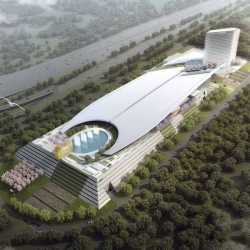In November, Maryland residents will vote on a statewide referendum to determine whether casino revenues which go to the state can be used for anything but K-12 education.
This is not the first time the issue of casino revenue and education have come up. However, with the addition of the MGM National Harbor casino at the end of 2016 and the much-increased tax revenue it has brought to the state, the issue is being reviewed again.
Many states segregate gambling revenues into school funds and scholarship funds, as lawmakers have found pro-gambling legislation often is more palatable if it helps public education. While one can wonder if revenues going into the General Fund really are segregated, both state lotteries and casino gaming revenues often are earmarked for school funding.
Maryland voters get to decide this year if their state’s casinos will do the same.
MGM National Harbor 2016 Opening
MGM National Harbor casino opened Dec. 8, 2016. After its first full year of operating, the casino has lived up to high expectations for Prince George’s County residents and MGM Resorts as well.
The casino, which is located about 10 miles outside of Washington DC and is owned by Las Vegas-based MGM Resorts International, employs over 3,700 people. A large chunk of those staff members, 45%, are Prince George’s County locals.
By the end of 2017, the casino and hotel said they had reached capacity 242 nights and had seen over 6 million visitors. The resort is now Prince George’s County’s leading tax provider.
MGM National Harbor’s Local Impact
The MGM National Harbor casino is not only a hot spot for gamblers, but it is a prime entertainment spot for local residents who do not enjoy gambling. Local residents often complain about land-based casinos, due to the increased traffic gaming destinations bring. MGM Resorts says their feedback from residents has been quite positive.
Patrick Fisher, the executive director of hotel operations at MGM National Harbor, said of the casino-resort, “We have a great theater with world-class acts, an amazing conservatory that gets changed out five times per year, 15 retail stores, 12 food and beverage outlets, a world-class hotel, spa and salon, so much to offer to anyone that’s coming and looking to be entertained.”
How Maryland Uses Casino Revenues
According to a report just after the end of fiscal year 2017, Prince George’s County has secured more than $32 million in revenue from the new casino. More than half of that revenue went straight to Prince George’s County’s treasury. The county also received money from Maryland’s Education Trust Fund, which ends up coming back to the county through formula grants provided to Prince George’s County Public Schools.
The remaining 40% of the gaming revenues are paid by casinos, but this money does not go directly to the County. Instead, the casino cash goes to an array of funds, including the Maryland Education Trust Fund, the state’s horse racing industry, and the Maryland General Fund.
If the November 2018 vote is a success, then the way MGM National Harbor’s revenues are dispersed will be changed significantly.
Maryland’s K-12 Education Fund
Last Friday, the Maryland General Assembly gave final approval to a measure proposing a constitutional amendment. This amendment, if passed, would change the way the state’s casino revenue is disperse. The bill eventually would bar the state from using those funds for anything other than education.
As a constitutional amendment, the measure goes directly to a referendum vote and does not require Gov. Larry Hogan’s approval. The proposal has already passed both chambers by wide margins.
The amendment calls for all of the state’s 6 casino’s annual revenue to be dedicated to supplementing education spending by a final date of July 1, 2022. The state’s gambling revenue is projected to be $517 million.
Gov. Hogan’s Lockbox Plan
The Maryland electorate approved expanded gambling in the state in 2008 and 2012 votes, but in each case, they signaled a desire to have the casino taxes go to education. Since then, politicians have tried to figure out the best system for implementing that plan.
The legislature bypassed many other proposals, including one from Gov. Hogan. In February 2018, Hogan released a proposal for a so-called lockbox requirement system. Hogan’s approach would have given future legislatures easy access to raid the lockbox, so lawmakers voted down the proposal.
The K-12 Education Fund amendment promises that, if passed, it would fulfill the intentions that voters had when they approved the 2008 and 2012 ballot questions regarding the expansion of gambling in Maryland.

